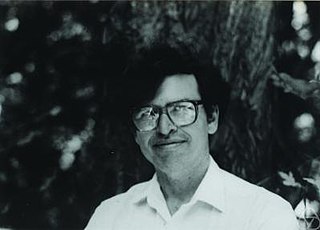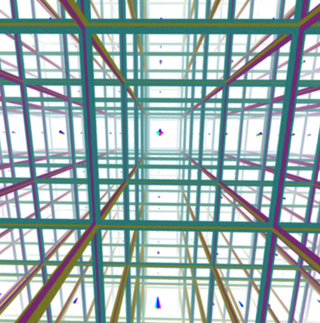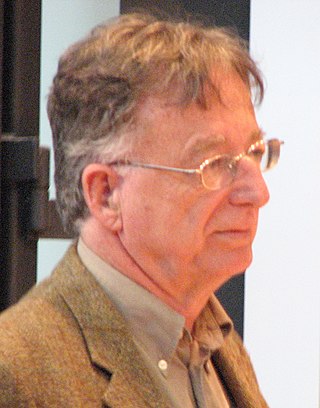Related Research Articles

William Paul Thurston was an American mathematician. He was a pioneer in the field of low-dimensional topology and was awarded the Fields Medal in 1982 for his contributions to the study of 3-manifolds.

In mathematics, a 3-manifold is a space that locally looks like Euclidean 3-dimensional space. A 3-manifold can be thought of as a possible shape of the universe. Just as a sphere looks like a plane to a small enough observer, all 3-manifolds look like our universe does to a small enough observer. This is made more precise in the definition below.

In mathematics, a Kleinian group is a discrete subgroup of the group of orientation-preserving isometries of hyperbolic 3-space H3. The latter, identifiable with PSL(2, C), is the quotient group of the 2 by 2 complex matrices of determinant 1 by their center, which consists of the identity matrix and its product by −1. PSL(2, C) has a natural representation as orientation-preserving conformal transformations of the Riemann sphere, and as orientation-preserving conformal transformations of the open unit ball B3 in R3. The group of Möbius transformations is also related as the non-orientation-preserving isometry group of H3, PGL(2, C). So, a Kleinian group can be regarded as a discrete subgroup acting on one of these spaces.
In the mathematical subfield of 3-manifolds, the virtually fibered conjecture, formulated by American mathematician William Thurston, states that every closed, irreducible, atoroidal 3-manifold with infinite fundamental group has a finite cover which is a surface bundle over the circle.
In mathematics, the tameness theorem states that every complete hyperbolic 3-manifold with finitely generated fundamental group is topologically tame, in other words homeomorphic to the interior of a compact 3-manifold.
In topology, an area of mathematics, the virtually Haken conjecture states that every compact, orientable, irreducible three-dimensional manifold with infinite fundamental group is virtually Haken. That is, it has a finite cover that is a Haken manifold.

In mathematics, a Schottky group is a special sort of Kleinian group, first studied by Friedrich Schottky (1877).

Dennis Parnell Sullivan is an American mathematician known for his work in algebraic topology, geometric topology, and dynamical systems. He holds the Albert Einstein Chair at the City University of New York Graduate Center and is a distinguished professor at Stony Brook University.
Lipman Bers was a Latvian-American mathematician, born in Riga, who created the theory of pseudoanalytic functions and worked on Riemann surfaces and Kleinian groups. He was also known for his work in human rights activism.
In mathematics, more precisely in group theory and hyperbolic geometry, Arithmetic Kleinian groups are a special class of Kleinian groups constructed using orders in quaternion algebras. They are particular instances of arithmetic groups. An arithmetic hyperbolic three-manifold is the quotient of hyperbolic space by an arithmetic Kleinian group.
James W. Cannon is an American mathematician working in the areas of low-dimensional topology and geometric group theory. He was an Orson Pratt Professor of Mathematics at Brigham Young University.
In hyperbolic geometry, the ending lamination theorem, originally conjectured by William Thurston (1982), states that hyperbolic 3-manifolds with finitely generated fundamental groups are determined by their topology together with certain "end invariants", which are geodesic laminations on some surfaces in the boundary of the manifold.
In mathematics, the Ahlfors conjecture, now a theorem, states that the limit set of a finitely-generated Kleinian group is either the whole Riemann sphere, or has measure 0.
In mathematical complex analysis, universal Teichmüller spaceT(1) is a Teichmüller space containing the Teichmüller space T(G) of every Fuchsian group G. It was introduced by Bers (1965) as the set of boundary values of quasiconformal maps of the upper half-plane that fix 0, 1, and ∞.
In mathematics, the curve complex is a simplicial complex C(S) associated to a finite-type surface S, which encodes the combinatorics of simple closed curves on S. The curve complex turned out to be a fundamental tool in the study of the geometry of the Teichmüller space, of mapping class groups and of Kleinian groups. It was introduced by W.J.Harvey in 1978.

Jeffrey Farlowe Brock is an American mathematician, working in low-dimensional geometry and topology. He is known for his contributions to the understanding of hyperbolic 3-manifolds and the geometry of Teichmüller spaces.
Albert Marden is an American mathematician, specializing in complex analysis and hyperbolic geometry.
Pekka Pertti Tukia is a Finnish mathematician who does research on Kleinian groups and their geometric properties.
In mathematics, a Cannon–Thurston map is any of a number of continuous group-equivariant maps between the boundaries of two hyperbolic metric spaces extending a discrete isometric actions of the group on those spaces.
References
- Bers, Lipman (1970), "On boundaries of Teichmüller spaces and on Kleinian groups. I", Annals of Mathematics , Second Series, 91: 570–600, doi:10.2307/1970638, ISSN 0003-486X, JSTOR 1970638, MR 0297992
- Brock, Jeffrey F.; Bromberg, Kenneth W. (2003), "Cone-manifolds and the density conjecture", Kleinian groups and hyperbolic 3-manifolds (Warwick, 2001), London Math. Soc. Lecture Note Ser., vol. 299, Cambridge University Press, pp. 75–93, arXiv: math/0210484 , doi:10.1017/CBO9780511542817.004, MR 2044545
- Brock, Jeffrey F.; Bromberg, Kenneth W. (2004), "On the density of geometrically finite Kleinian groups", Acta Mathematica , 192 (1): 33–93, arXiv: math/0212189 , doi:10.1007/BF02441085, ISSN 0001-5962, MR 2079598
- Bromberg, K. (2007), "Projective structures with degenerate holonomy and the Bers density conjecture", Annals of Mathematics , Second Series, 166 (1): 77–93, arXiv: math/0211402 , doi:10.4007/annals.2007.166.77, ISSN 0003-486X, MR 2342691
- Namazi, Hossein; Souto, Juan (2012), "Non-realizability and ending laminations: Proof of the density conjecture", Acta Mathematica , 209 (2): 323–395, doi: 10.1007/s11511-012-0088-0 , ISSN 0001-5962
- Ohshika, Ken'ichi (2011), "Realising end invariants by limits of minimally parabolic, geometrically finite groups", Geometry and Topology , 15 (2): 827–890, arXiv: math/0504546 , doi:10.2140/gt.2011.15.827, ISSN 1364-0380
- Series, Caroline (2005), "A crash course on Kleinian groups", Rendiconti dell'Istituto di Matematica dell'Università di Trieste, 37 (1): 1–38, ISSN 0049-4704, MR 2227047, archived from the original on 2011-07-22